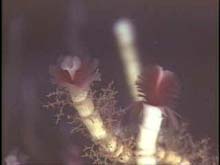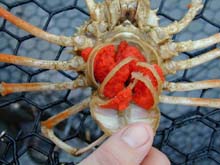
A close-up of tubeworms (Lamellibrachia luymesi) showing their bright red branchial plumes. The worms were preserved, and later dissected, to measure fecundity and other reproductive parameters. This work was done by Ana Hilario as part of her doctoral dissertation at the Southampton Oceanography Centre in the United Kingdom.
The Jaw Breakers
Student Report
February 11, 2003
Ali Helms, Master's Candidate
Oregon Institute of Marine Biology
University of Oregon
Today, our launch site was the Brine Pool, which is an underwater lake surrounded by mussels. Since it was only our third day to dive, and the weather was still questionable for the latter part of the cruise, the day was divided into three short dives, each lasting about two hours. With multiple experiments set up at the Brine Pool, these dives had to be well planned and task-oriented. Everyone was interested in this popular dive site. Various people were interested in mussel recruitment, "snot worm" physiology, tubeworm reproduction and symbioses, and even bacterial mats. Things don't always go as planned, however, and the morning dive took an interesting turn.
The Johnson Sea-Link II manned submersible launched at 8 am and reached a bottom depth of 2,120 ft about 33 min later. It was only 7.2 degrees C outside of the submersible, and the window began to fog up as I moved from the left porthole to the right porthole and back again. Meanwhile, the pilot maneuvered the submersible around using the sound from a pinger to locate an acoustic release mooring, which would then be transported to the east side of the Brine Pool and attached to a cage filled with mussels. On a later cruise, the caged mussels will be recovered and brought to the surface via an acoustic release device. This method is a more efficient way to collect mussels than using an expensive submersible; unfortunately, this task is easier said than done.
As we were working, I noticed that the porthole began to fill with a cloudy white haze, and the pilot expressed disappointment as he explained that a hose on the jaws (an essential tool for sample collecting) had broken. The white fluid that I saw was hydraulic fluid from the broken jaws. Luckily, a separate tool called the "scoop" still worked, and we were able to fill the cage with mussels anyway. Without the jaws, however, the rest of our dive had to be aborted, and we returned to the surface at 9:13 am.
As the sun rose and we saw its light from 1,150 ft below the surface, our worries about the day began to disappear. Thankfully, our early morning problems were not indicative of the rest of the day. The other two dives ran smoothly and the unfinished tasks left from the morning dive were completed. By the end of the day, we had recorded data on mussel recruitment, exposed orbiniid worms to experimental hypersalinity conditions, dissected tubeworms, fed clams in clearance-rate experiments, and processed bacterial cores. In the end, the eager scientists did not let the unpredictable weather and interrupted dives interfere with their fascinating work.

One of two large spider crabs brought up in a trap. This one carried thousands of developing embryos attached to her abdomen (seen here as an orange mass). The other was covered with epibiotic lepadomorph barnacles. Click image for larger view.
Snow and Fireworks Under the Ocean
Student Report
February 11, 2003
Jennifer Head, Doctoral Candidate
Oregon Institute of Marine Biology
University of Oregon
At 4:30 pm, we started our descent to the sea floor. The submersible tender, sharing the back of the submersible with me, was explaining the intricacies of its interior workings. I was trying hard to pay attention to him and to ignore the fact that I was about to have the most amazing experience of my life. He explained that our oxygen flow was set at 1L/min, which made me feel like I was sitting in a small, experimental chamber used for measuring oxygen consumption!
At 1,600 ft, the light from the surface disappeared, and we were cast into perpetual darkness. The world suddenly lit up around us; all the small organisms and pieces of organic matter that, at first, resembled snow, had magically transformed into millions of brilliantly glowing creatures. Eventually, however, we had to turn the submersible lights on to conduct our work. We were heading toward the Brine Pool, a body of hypersaline water sitting in a crater on the ocean floor. This hypersaline or super-salty water, called "brine," is heavier than normal seawater, and thus it sinks to the bottom of the crater. When the submersible got too close to the crater, it generated a small wave of brine over the mussels around the periphery of the pool. The sight of the brine mixing with the normal seawater reminded me of heat waves coming off the sidewalk on a hot summer day.
When we finished setting up and retrieving several experiments for the scientists on the ship, we began our ascent. The fireworks show had begun! The sea around us reminded me of standing in a big, open field with a heaving snow falling, except that the "sky" and "ground" were pitch black and the "snow" consisted of green and blue fluorescent organisms. It was evening by this time, and no light was coming from the surface to spoil the view. Some of the aggregations of smaller organisms exploded like fireworks as they bumped into the side of the submersible. The larger creatures, mostly jellyfish, swam aimlessly as they pulsated through the water column. It is hard to convey my excitement at the view as we ascended to the surface; my feet have not quite touched the ground since! As we arrived at the surface, I was forced back to reality, because there was still work to be done--organisms and experiments had to be unloaded from the biobox and transported immediately to the cold room. I had collected new crab specimens to study and new stories to tell.









